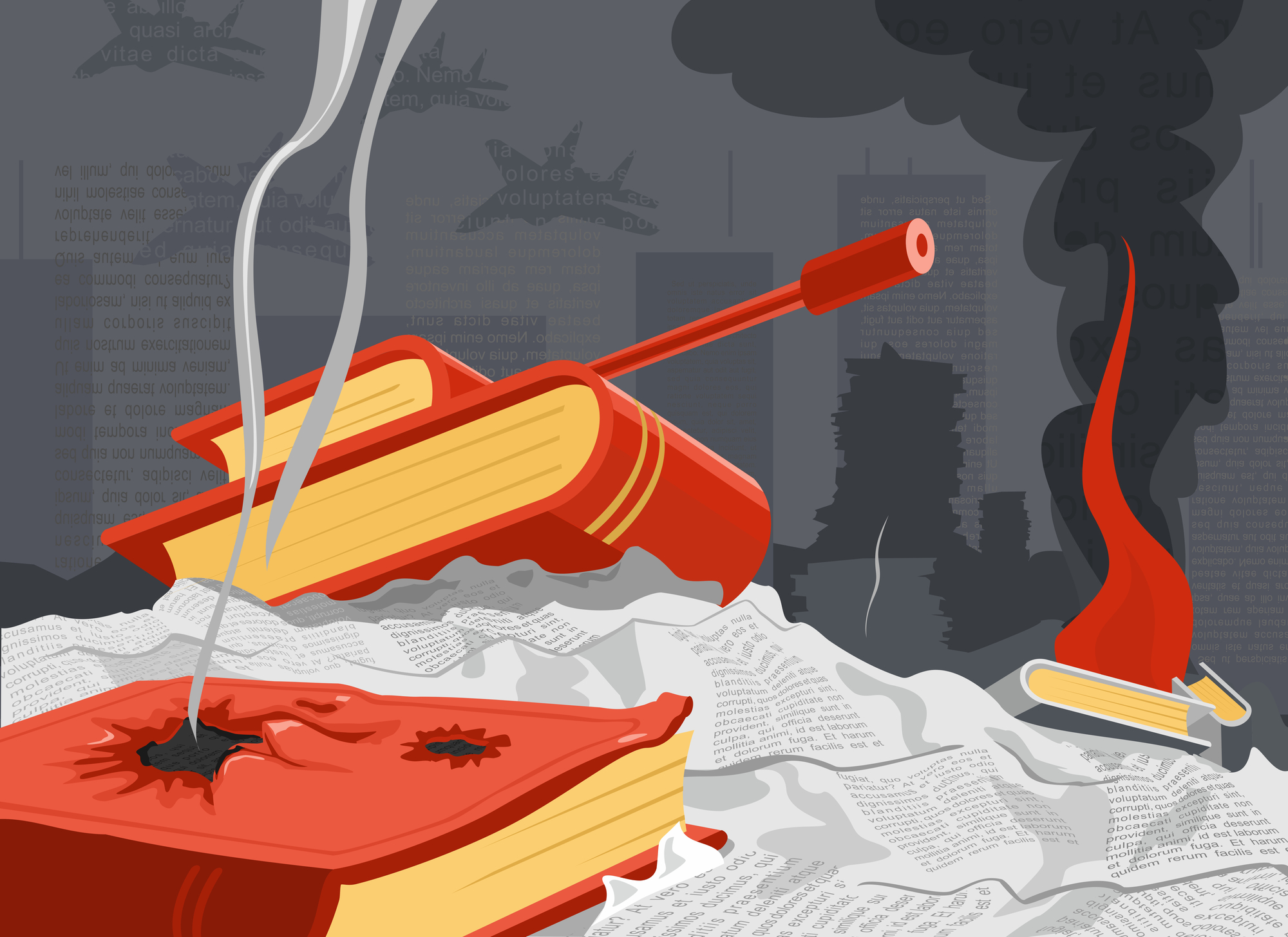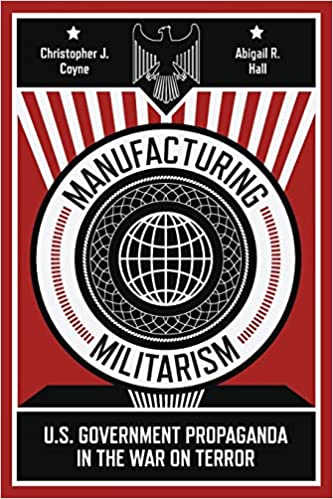The War That Never Ends
By Nathan Goodman


- A Book Review of Manufacturing Militarism: U.S. Government Propaganda in the War on Terror, by Christopher J. Coyne and Abigail R. Hall.1
It’s been over 20 years since the 9/11 attacks. Ever since those horrible attacks, the United States government has been waging a “war on terror” both at home and abroad.
The war on terror has fundamentally reshaped our lives. The TSA’s invasive searches have become a prerequisite for air travel. Millions of Americans have had their phone records and other metadata intercepted by the National Security Agency. According to the Costs of War Project at Brown University2, the U.S. government has spent over $8 trillion on the war on terror. They also find disturbing human costs, including over 900,000 deaths in the war on terror.
The war on terror has been going on for most of my life. Many college students today have been living with the war on terror for their entire lives.
These students might wonder whether economics has anything relevant to say about the world they live in, especially if they’re just taught a set of abstract models. But economics is not just a set of abstract models on a blackboard. Economics is a way of thinking. As Peter Boettke says, the economic way of thinking is a set of eyeglasses that help us clearly see the world around us. In Manufacturing Militarism, Christopher J. Coyne and Abigail R. Hall use economics to explain the war on terror.
More specifically, Coyne and Hall use economics to explain the role of government propaganda in the war on terror. They quote philosopher Jason Stanley’s definition of propaganda as having “three key characteristics”:
- “First, propaganda is purposefully biased or false. Its purpose is to deter people from having access to truthful information. Second, propaganda is used to promote a political cause. Third, propaganda is bad from the perspective of those targeted by the propagandist’s message because it limits their ability to make an informed judgment.”
While they acknowledge that propaganda can exist in many spheres of life, they focus on government propaganda and the U.S. national security state. They illuminate this important phenomenon using a mix of economic theory and illustrative history.
Economic theorists use models to analyze the social world. One such model describes the ideal protective state. In this model, citizens have access to information about public officials’ performance. Acting on this information, they can hold officials accountable. This creates incentives for officials to act in the interest of citizens. Under this model, there is no need for propaganda. If officials are already acting as citizens wish, then officials do not need propaganda to secure the citizens’ support. There is also no room for propaganda within this model. Citizens are assumed to have sufficient information that they will not be fooled.
But as Hall and Coyne persuasively show, real-world governments deviate sharply from this idealized model. Actual states are characterized by principal-agent problems. A principal-agent problem happens when one person (the principal) owns an asset but actual control is in the hands of someone who is supposed to act on their behalf, their “agent.” For example, corporations “are owned by shareholders who must rely on those hired to manage the firm to serve their interests.” The agent will often know things that the principal does not. This asymmetric information means that there is room for the agent to act opportunistically, which undermines the interest of the principal.
Principal-agent problems don’t just apply to corporations. Democratic states are full of them! The citizens of a democratic state can be understood as principals, and public officials as the citizens’ agents. You might think that public officials have strong incentives to act in the interests of citizens. After all, citizens have the power to vote politicians out of office.
But Coyne and Hall point out a variety of factors that undermine democratic feedback. One such factor is rational ignorance. Since a single vote is unlikely to change the outcome of an election, voters have very little incentive to acquire detailed information about government officials’ actions. Even if they do acquire such information, the time delays between elections mean that they often cannot penalize elected officials until it is too late to reverse their actions. This creates slack in the system that special interests, both private corporations and public employees, can exploit. And of course, the secrecy associated with national security policy makes these issues even more severe. This means that the ideal state model does not hold, and there is substantial room for powerful government officials to use propaganda to manipulate the public.
The economic analysis that Coyne and Hall offer is classic public choice theory. Public choice theorists use the tools of economics to offer a clear-eyed analysis of government. Rather than assuming benevolence, they study the incentives facing voters, vote-seeking politicians, bureaucrats, and contractors.
But Coyne and Hall offer more than theory. They use real world examples to show that the theory is empirically relevant.
Towards the beginning of the book, Coyne and Hall discuss the long history of U.S. government war propaganda. They trace war propaganda all the way back to the American Revolution and offer especially insightful analysis of propaganda during the two World Wars and the Cold War. Ultimately, this is just setting the stage for their main focus: the ongoing war on terror that continues to shape our lives.
The war on terror is multifaceted. One of the most consequential aspects was the invasion and occupation of Iraq. Many Americans now know that the invasion was sold based on false claims, such as assertions that Saddam Hussein was involved in the 9/11 attacks and that he was developing weapons of mass destruction. But how did the Bush administration convince so many Americans of these falsehoods?
Anyone who wants to better understand the propaganda used to sell the invasion of Iraq should read this book. Coyne and Hall carefully explain what officials knew and what they said, showing “the disconnect between what was known by U.S. government officials and what was presented to the public.” They also show how administration officials used the media to launder false claims. Sources within the administration would leak information to the press, such as claims that intercepted aluminum tubes were strong evidence of an Iraqi nuclear weapons program. Then when the New York Times reported on this, officials like Condoleeza Rice and Vice President Dick Cheney referenced the story “as an indication of independent credibility outside the administration.”
The propaganda continued after the invasion, with officials actively working to shape public opinion about the war. They continued to use the media laundering strategy. They embedded journalists with American troops, which altered the incentives and information available to those journalists. Individuals with direct ties to defense contractors, lobbyists, and the Pentagon appeared on television news but were presented as independent experts.
Media reporting on the war on terror was substantially distorted by U.S. government propaganda. Could Americans avoid such propaganda by tuning out the news? Sadly not. As Coyne and Hall show, Americans are inundated with government propaganda when they watch sporting events, go to the airport, and watch summer blockbusters.
The Department of Defense has spent millions of dollars sponsoring “patriotic displays” at sporting events, especially NFL football games. And “paid patriotism” is not the only form of post-9/11 sports propaganda. When Pat Tillman left the NFL to join the army, government officials began to use his military service as a propaganda opportunity. After he was killed by friendly fire in Afghanistan, high-ranking officials in the U.S. government concealed information about his death. Coyne and Hall carefully document what officials knew, the gap between what was known and what was said publicly, and how this deception served a pro-war narrative.
Every time Americans fly commercially, they are required to travel through checkpoints maintained by the Transportation Security Administration (TSA). Coyne and Hall compellingly argue that the TSA does not make Americans safer. Moreover, the TSA engages in propaganda through a mix of “security theater” and “threat inflation.” Their actions thereby promote the broader framework of the war on terror, even if they do not support a specific conflict. But this security theater comes at a serious cost for civil liberties, and can be particularly harmful to some air travelers, such as those with “prosthetic breasts, colostomy bags, and other medical devices.” People are subjected to humiliating treatment, and it’s more for show than for any measurable security benefits.
We also encounter propaganda when we go to the movies. Many films are produced using resources offered by the Department of Defense, such as military hardware. But to access these resources, filmmakers grant the Department of Defense veto power over their scripts. This alters the messages and ideas conveyed in movies and television shows. Government resources are used as a carrot to encourage filmmakers to send more favorable messages about American militarism.
Manufacturing Militarism offers a compelling mix of theory and history. Coyne and Hall show us how useful economics can be for understanding the war on terror and the propaganda that sustains it. I hope their book inspires future research on these issues. I think their framework could be applied fruitfully to understand the role of propaganda and threat inflation in immigration policy, for example. Or the role that propaganda plays in America’s drone wars and airstrikes abroad.
In addition to inspiring future research, I hope that Manufacturing Militarism inspires readers to think critically about government power, and creatively about how to resist militarism. As Ludwig von Mises said, “Peace builds, war destroys.” In a world where warfare and militarism continue to inflict significant destruction around the world, it’s up to us to restore peace and the productive social cooperation that it fosters.
Footnotes
[1] Christopher J. Coyne and Abigail R. Hall, Manufacturing Militarism: U.S. Government Propaganda in the War on Terror. Stanford University Press, 2021.
[2] Available online at Costs of War. Watson Institute, Brown University.
*Nathan P. Goodman is a Postdoctoral Fellow in the Department of Economics at New York University. His research interests include defense and peace economics, self-governance, public choice, institutional analysis, and Austrian economics.
